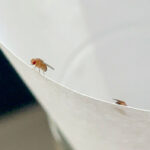Got tiny flying bugs buzzing around your fruit bowl or kitchen sink? You might be dealing with fruit flies! These common household pests can be a nuisance, but thankfully, you don’t need harsh chemicals or expensive solutions to get rid of them. Using simple household items, you can create effective fruit fly traps and take steps to prevent future infestations. Having recently experienced a fruit fly invasion in my own home, I decided to put various elimination methods to the test. After careful experimentation and detailed notes, I’m excited to share the best DIY fruit fly traps and prevention strategies that actually work.
These homemade traps are incredibly easy to assemble using natural ingredients you likely already have in your kitchen. They are also a humane and chemical-free approach to managing these pests. Whether you prefer to eliminate fruit flies or release them outdoors, these methods offer options for everyone. Plus, we’ll cover essential tips to keep fruit flies from becoming a problem in your home in the first place.
Understanding Fruit Flies
Fruit flies are small, winged insects that are strongly attracted to ripe and fermenting fruits and vegetables – their name is quite descriptive! They are also drawn to sugary spills, alcoholic beverages, and other sweet or decaying organic matter. You’ll often find them hovering around fruit bowls, garbage disposals, trash cans, and even drains. They are about the size of a grain of rice and resemble small houseflies, typically tan or brownish with distinctive red eyes. Fruit flies are most prevalent during the warmer months of summer and fall when fruits are abundant and temperatures are ideal for their breeding.
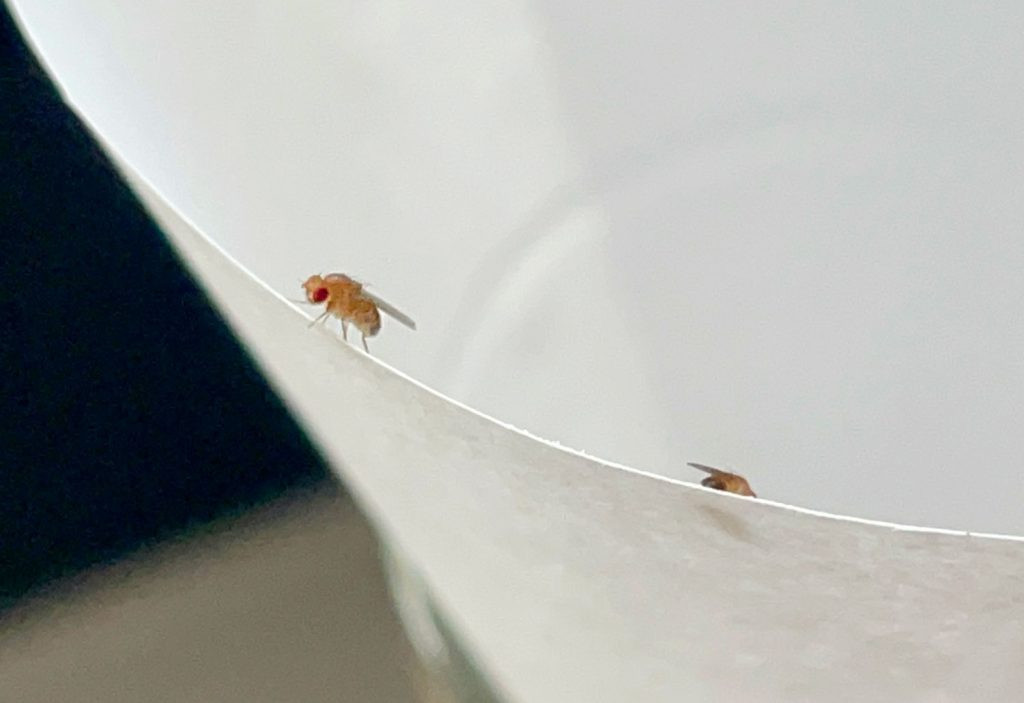 Close Up Of Fruit Fly On Paper Funnel
Close Up Of Fruit Fly On Paper Funnel
Alt text: Detailed close-up of a fruit fly perched on the edge of a paper funnel, illustrating the small size and red eyes characteristic of fruit flies, ideal for a guide on how to capture fruit flies.
A fruit fly infestation often begins when a few individuals are brought into your home on fruits or vegetables from the grocery store or garden. However, their rapid reproduction cycle is what turns a few flies into a major problem. Female fruit flies can lay hundreds of eggs in their short lifespan, and these eggs can hatch in as little as 12 hours. The larvae mature into adults within days, leading to a swift population explosion. This rapid breeding is why quick action is crucial to eliminate fruit flies as soon as you spot them.
Identifying Fruit Flies: Fruit Flies vs. Fungus Gnats vs. Drain Flies
It’s easy to mistake fruit flies for other small flying insects commonly found indoors, particularly fungus gnats and drain flies. While all are small and annoying, accurate identification is key to choosing the most effective elimination method. The easiest way to tell them apart is by observing where you see them and what larger insect they resemble.
- Fruit Flies: Resemble small flies. Found near ripe fruit, vegetables, garbage, and sugary substances.
- Drain Flies: Resemble small, fuzzy moths. Typically seen around sinks, drains, and damp areas.
- Fungus Gnats: Resemble small mosquitos. Usually found near houseplants, as they breed in moist potting soil.
If you are uncertain about which pest you’re dealing with, trying one of the fruit fly traps described below is a good diagnostic step. If the trap attracts the insects in your home, you can confirm you have fruit flies and proceed with targeted elimination.
4 Simple DIY Fruit Fly Trap Recipes
Getting rid of fruit flies doesn’t require complex procedures or expensive products. With just a few common household items and a bit of patience, you can effectively trap and eliminate them. The principle behind each of these traps is simple: attract the fruit flies with a tempting bait and then prevent their escape. I experimented with the following 4 DIY methods and discovered a clear winner in terms of effectiveness. Since each method uses items you likely already have at home, it’s worthwhile to try more than one to see what works best for you. Consider it a fun, mini science experiment in your kitchen! Here are the first 4 fruit fly trap recipes I tested:
- Paper Funnel Trap
- Plastic Wrap Trap
- Dish Soap Trap
- Rotting Fruit Trap
Below, I’ll provide detailed instructions for each method, along with my personal verdict on their performance. Keep in mind that some traps work faster than others, and it may take several days of consistent trapping to fully resolve your fruit fly issue.
#1: The Paper Funnel Fruit Fly Trap
This trap design lures fruit flies into a container through a narrow opening at the bottom of a paper funnel. The flies are attracted to the bait inside, but the funnel’s shape makes it difficult for them to find their way back out.
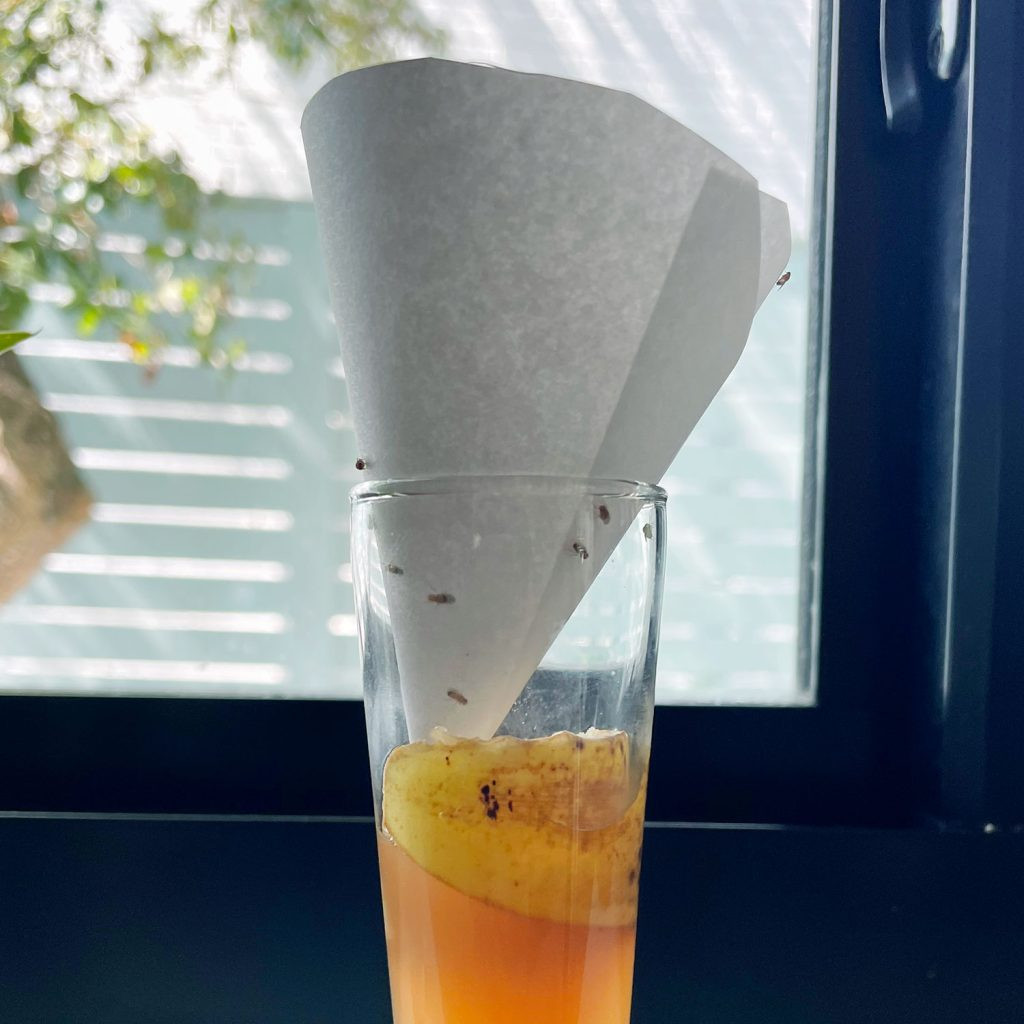 DIY Fruit Fly Trap With Paper Funnel
DIY Fruit Fly Trap With Paper Funnel
Alt text: Step-by-step visual guide for creating a DIY fruit fly trap using a paper funnel, showing a jar with apple cider vinegar and a paper funnel inserted into the opening, demonstrating a simple method for how to capture fruit flies.
Supplies you’ll need:
- Small, clear jar, cup, or container – a narrow opening is preferable
- Sheet of paper or cardstock
- Tape
- Scissors
- Apple cider vinegar (ACV)
Instructions:
- Select your container: Choose a small, clear container such as a repurposed food jar or a plastic bottle. For this trap, a container with a smaller opening works best.
- Add the attractant: Pour a small amount of apple cider vinegar, old beer, or wine into the bottom of your container. These liquids are very effective at attracting fruit flies.
- Construct the paper funnel: Roll a piece of paper or cardstock into a cone shape, ensuring a very tiny opening at the pointed end. Secure the cone shape with tape. You can trim the tip to create the small opening if it’s easier. The opening should be just large enough for a fruit fly to enter, about the size of a grain of rice.
- Position the funnel: Place the paper funnel into the opening of your container. You might need to adjust the funnel’s shape so it sits securely on the rim of the container without touching the liquid bait. Ensure there are no gaps around the funnel’s edges where flies could escape.
- Humane removal option (optional): To release captured fruit flies, carefully carry the entire trap outdoors without disturbing the funnel. Once outside, remove the funnel and allow the flies to fly away.
While you can use a store-bought funnel, the opening at the bottom is often too wide, which can allow trapped fruit flies to escape. A homemade paper funnel is more effective due to its customizable narrow opening.
#2: The Plastic Wrap Fruit Fly Trap
Similar to the funnel trap, this method uses apple cider vinegar to attract fruit flies. The flies enter through small holes poked in plastic wrap stretched tightly over the container opening, but then struggle to exit.
Supplies you’ll need:
- Small, clear jar, cup, or container
- Rubber band
- Plastic wrap or a plastic bag
- Toothpick
- Apple cider vinegar (ACV)
Instructions:
- Choose your container: Select a small, clear jar, cup, or any glass container. Almost any size will work, and clarity helps you monitor your trap’s success. An old can also works if you don’t have a clear container.
- Pour in the bait: Add apple cider vinegar to the container. The enticing scent will attract the fruit flies. Old beer or wine are also good alternatives, but avoid using regular white vinegar as it’s not as attractive to fruit flies.
- Seal with plastic wrap: Stretch plastic wrap tightly over the container opening and secure it firmly with a rubber band. Saran wrap works well, or you can repurpose a piece of plastic bag.
- Create entrance holes: Use a toothpick to poke a few small holes in the plastic wrap top. You don’t need many holes, just enough for fruit flies to enter. Ensure the holes are large enough for a fly to pass through.
- Humane release option (optional): To release the trapped flies, carefully take the entire trap outside, ensuring the plastic wrap remains in place. Remove the plastic wrap outdoors to let the flies escape.
For a variation, you can also use a metal jar lid instead of plastic wrap. Puncture a small hole in the metal lid using a hammer and nail, creating a similar entry point for the fruit flies. Mason jars or old food jars with metal lids work well for this adaptation.
#3: The Dish Soap Fruit Fly Trap
This trap differs from the previous two by not requiring a cover. Instead, it utilizes dish soap to break the surface tension of the liquid bait, trapping the fruit flies when they land. Note: This method is not designed for releasing fruit flies, as they will be coated in soap.
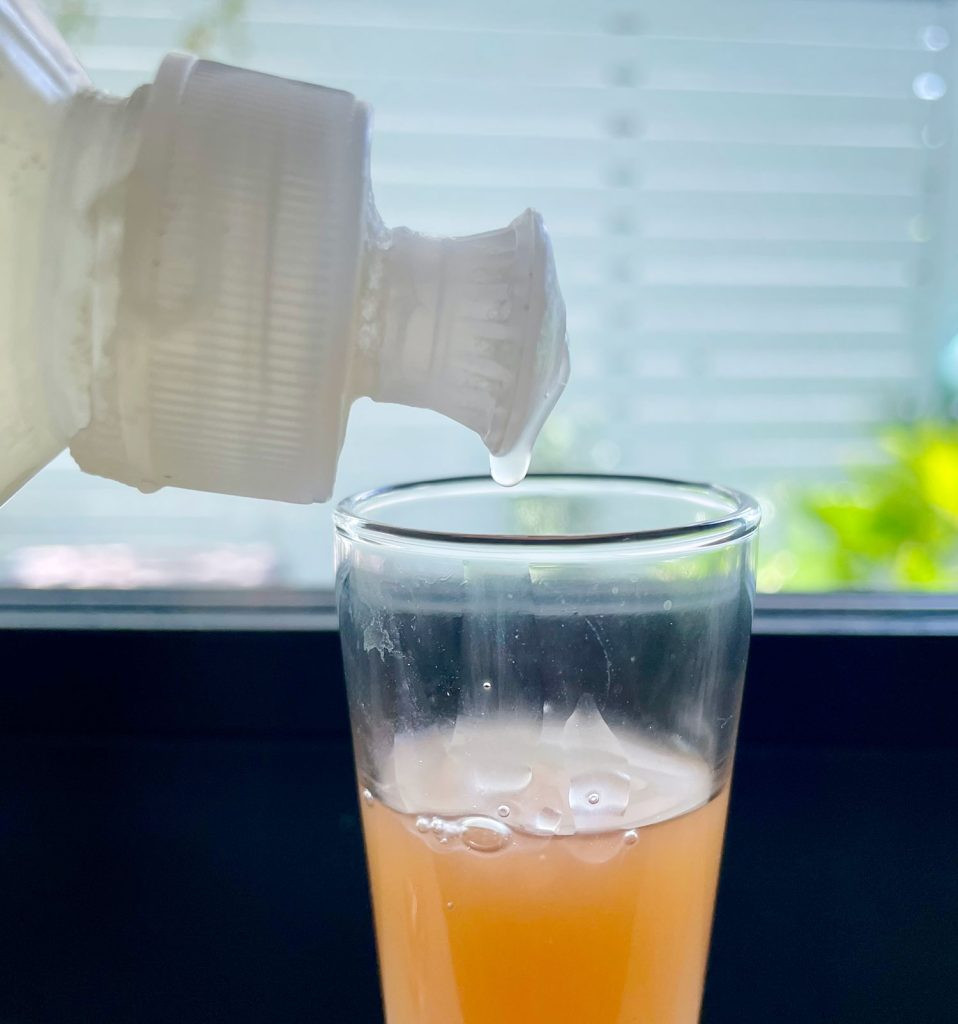 Dripping Dish Soap Into Apple Cider Vinegar For DIY Fruit Fly Trap
Dripping Dish Soap Into Apple Cider Vinegar For DIY Fruit Fly Trap
Alt text: Close-up shot of dish soap being dripped into a bowl of apple cider vinegar, illustrating the simple preparation of a dish soap fruit fly trap, a key method in learning how to capture fruit flies effectively.
Supplies you’ll need:
- Small container, bowl, or dish
- Dish soap
- Apple cider vinegar (ACV)
Instructions for this incredibly simple trap:
- Prepare the bait: Fill the bottom of a small container, bowl, or dish with apple cider vinegar. The sweet, fermented scent will attract the fruit flies.
- Add dish soap: Squirt several drops of dish soap into the apple cider vinegar. Gently mix to combine, creating a soapy solution. The dish soap reduces the surface tension, so when fruit flies land on the mixture, they will sink and become trapped.
This dish soap technique can also be enhanced by combining it with the plastic wrap or funnel trap methods. Simply add a few drops of dish soap to the apple cider vinegar before covering the container. This adds an extra trapping mechanism to your chosen trap design.
#4: The Rotting Fruit Fruit Fly Trap
To further explore fruit fly attractants, I also tested traps that replaced apple cider vinegar with fruit, which is naturally highly appealing to these pests.
Supplies you’ll need:
- Small glass jar, cup, or container
- Plastic wrap or paper funnel, depending on your chosen trap mechanism
- A small piece of ripe fruit, such as a banana peel or apple slice
To create a rotting fruit trap, simply substitute the apple cider vinegar in either the Plastic Wrap Trap or Funnel Trap with a piece of banana peel, apple slice, peach, or other ripe fruit. You can also add a fruit scrap to your apple cider vinegar bait for increased effectiveness. Be aware that fruit baits may need to be replaced every day or two to prevent unpleasant odors in your kitchen as the fruit decomposes.
Determining the Best Fruit Fly Trap
To visually compare the effectiveness of different trap combinations, I set up 4 distinct DIY traps to observe their performance side-by-side. The four homemade traps I tested were variations on the techniques described above:
- Plastic Wrap Trap with banana peel
- Funnel Trap with ACV + banana peel
- Plastic Wrap Trap with ACV + dish soap
- Dish Soap Trap with ACV
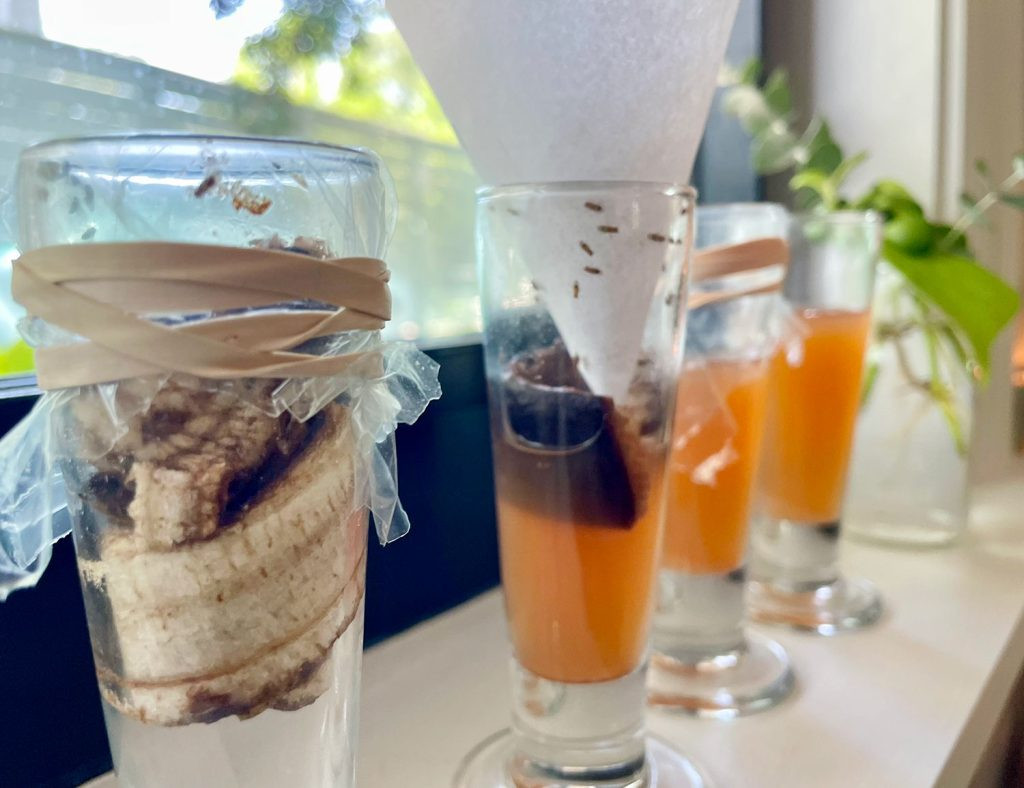 4 DIY Fruit Fly Traps Close Up
4 DIY Fruit Fly Traps Close Up
Alt text: A comparative image showcasing four different DIY fruit fly traps lined up, including plastic wrap and funnel variations with different baits like banana peel and apple cider vinegar, used in an experiment to determine how to capture fruit flies most effectively.
My results indicated that the type of bait was a more significant factor than the trap design itself. Traps baited with banana peel were significantly more successful than those using apple cider vinegar alone. While both Plastic Wrap Traps were structurally similar, the one containing banana peel captured dramatically more fruit flies compared to the ACV and soap trap. This suggests that while apple cider vinegar is effective, ripe fruit is an even more irresistible lure, especially when real fruit is present in the environment.
Therefore, my recommendation is to enhance any trap you choose by adding a piece of fruit as bait! I found a slight preference for the plastic wrap trap because it was simple to assemble and less prone to accidental spills. I learned this firsthand when I bumped the funnel trap and inadvertently released some captured flies back into the kitchen – oops!
What Bait Attracts Fruit Flies the Most?
Intrigued by the success of fruit baits, I expanded my experiment to determine which type of fruit is most attractive to fruit flies. I tested three readily available fruits: banana peel, apple slices, and a strawberry. Each fruit was placed in a Plastic Wrap Trap and positioned side-by-side on my kitchen counter for a 24-hour period.
While the banana peel initially seemed promising (it was the ripest at the start), the fruit flies ultimately showed the strongest preference for the strawberry. The banana peel still attracted a good number of flies, but the strawberry became increasingly effective as it ripened further. Interestingly, the apple slices didn’t capture a single fruit fly!
Store-Bought Fruit Fly Trap Options
If DIY traps aren’t working for you, or if you prefer a ready-made solution, there are numerous commercially available fruit fly traps. These products have generally positive reviews and are typically priced under $20. Store-bought traps might be a good option if you want a trap that targets a broader range of flying insects or if you prefer a more discreet appearance compared to homemade traps.
 Collage of Storebought Fruit Fly Traps
Collage of Storebought Fruit Fly Traps
Alt text: A collage displaying various store-bought fruit fly traps available for purchase, offering alternatives for those seeking ready-made solutions on how to capture fruit flies, and showing different designs for discreet pest control.
During my experiment, I purchased a pack of Terro Fruit Fly Traps to compare their performance against my homemade traps. I placed a Terro trap alongside my banana and strawberry traps for 24 hours to see which performed best.
Once again, my homemade strawberry trap was the most effective, followed closely by the banana peel trap. The store-bought trap only caught a single fruit fly in the initial 24-hour test. HOWEVER…
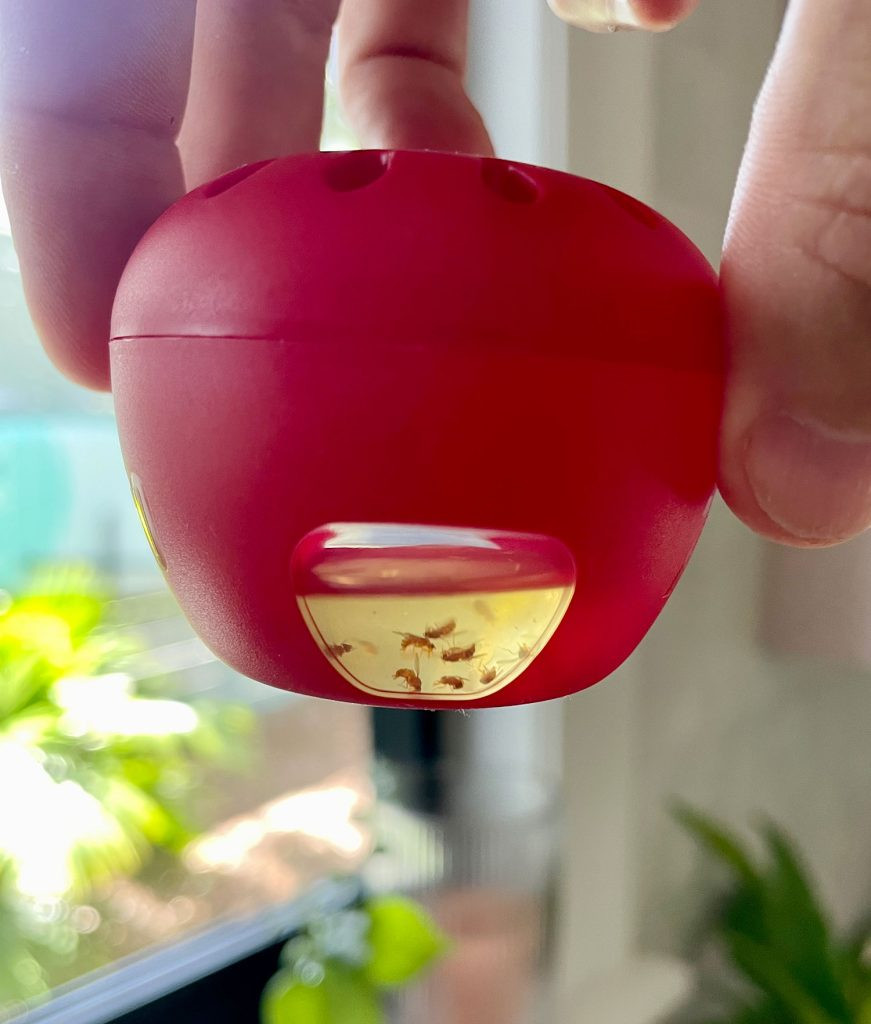 Terro Fruit Fly Trap With Dead Fruit Flies Visible
Terro Fruit Fly Trap With Dead Fruit Flies Visible
Alt text: A Terro fruit fly trap filled with captured dead fruit flies, demonstrating the effectiveness of store-bought traps over time, and providing a visual result of how to capture fruit flies using commercial products.
To ensure a fair comparison, I discarded my DIY traps and left the store-bought Terro trap out for another 24 hours. Over this extended period, the Terro trap accumulated the impressive collection of fruit flies you see in the image above. So, while the store-bought trap worked, it was not as immediately effective or as rapid in its capture rate as my homemade traps. My conclusion? Store-bought traps are a convenient, more aesthetically pleasing option, especially for long-term placement. However, homemade traps are incredibly effective for quick and immediate fruit fly control!
Preventing Fruit Flies in Your Home
While trapping fruit flies is relatively straightforward, preventing them from infesting your home in the first place is the ideal solution. Here are some simple yet effective preventative measures:
- Keep kitchen surfaces clean: Regularly wipe down kitchen counters, stovetops, tables, and all surfaces that might collect food residue or spills. Fruit flies are especially attracted to fruit, sugary liquids, and alcohol, so prompt cleanup is essential!
- Take out trash frequently: Food scraps left in your garbage can overnight can quickly become a breeding ground for fruit flies. Empty your trash cans daily, especially kitchen trash.
- Dispose of overripe fruit promptly: Monitor your fruit bowl for any fruits that are becoming overripe or starting to spoil. Discard them before they attract fruit flies and become a breeding site.
- Wash produce immediately after bringing it home: Washing fruits and vegetables as soon as you get them home from the store can remove any fruit fly eggs or larvae that may be present on the surface (except for berries, which can spoil faster if washed before storage).
- Store produce in the refrigerator when possible: Fruit flies do not thrive in cold temperatures. Refrigerating fruits and vegetables, especially ripe ones, can significantly reduce their attractiveness to fruit flies.
- Clean your sink drain regularly: Food particles and organic matter accumulating in your sink drain can attract fruit flies. Run your garbage disposal frequently and/or flush your drains regularly with hot water or a drain cleaner.
Finally, remember not to panic when you first notice fruit flies in your home. While it’s important to act quickly to prevent a full-blown infestation, the DIY solutions and prevention tips outlined here are easy to implement, effective, and fast-acting. You might even find yourself enjoying a bit of fruit fly science in the process, just like I did!
*This post contains affiliate links, so we may earn a small commission when you make a purchase through links on our site at no additional cost to you.
